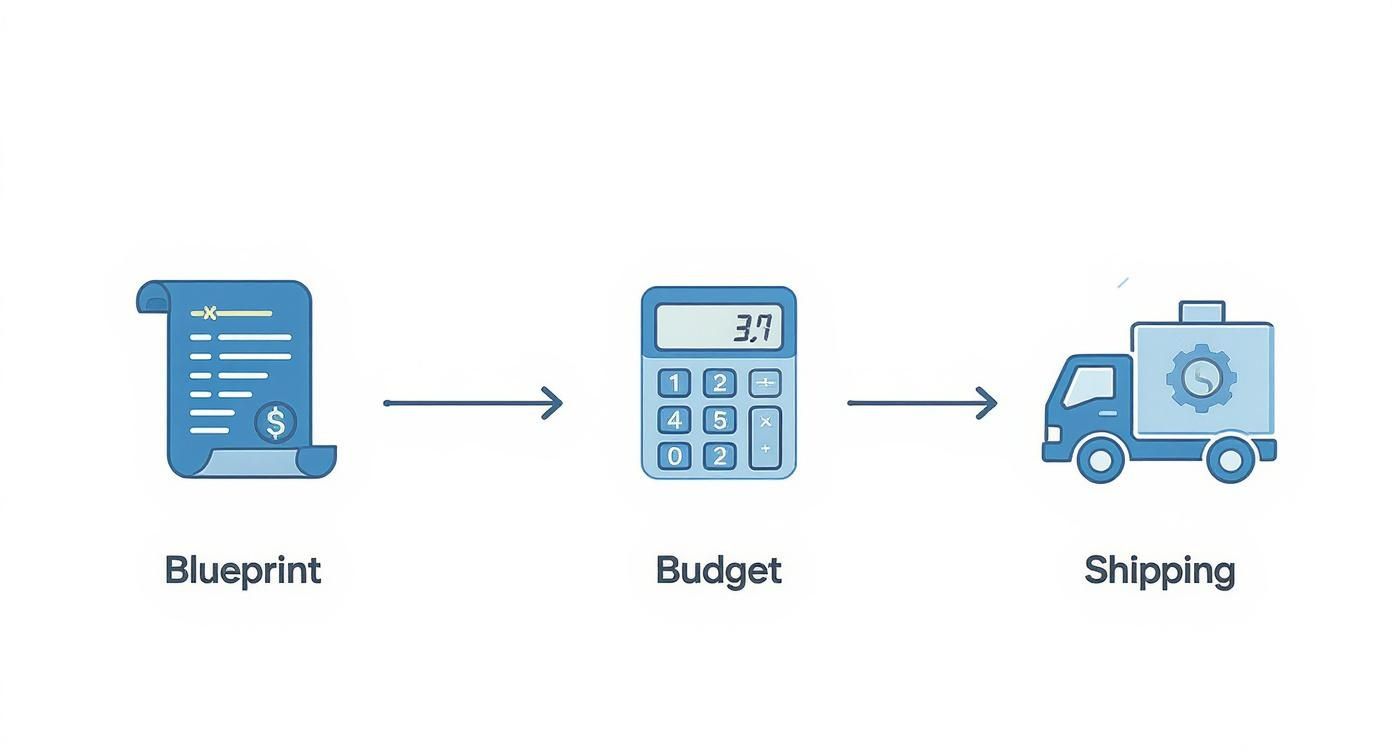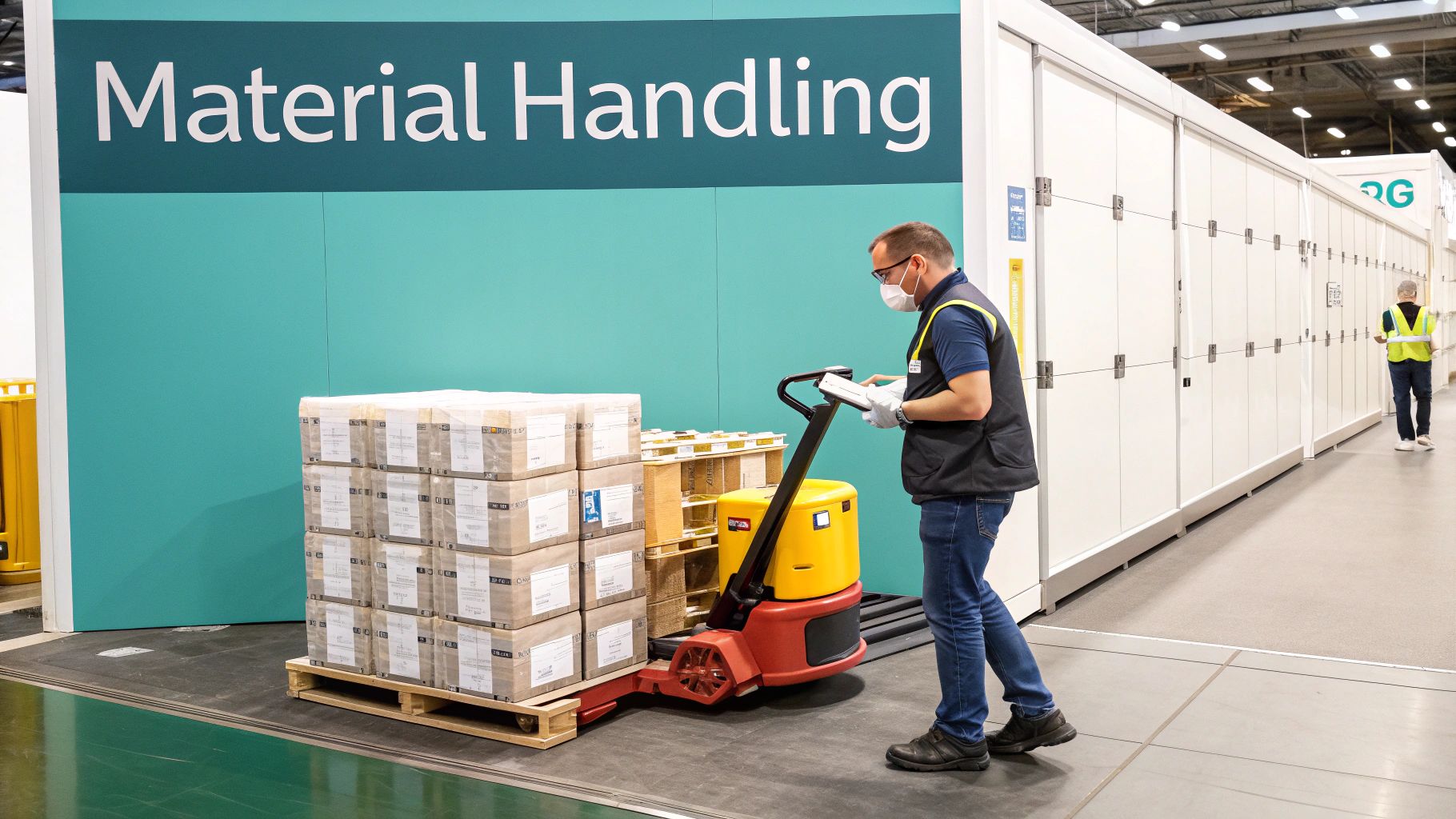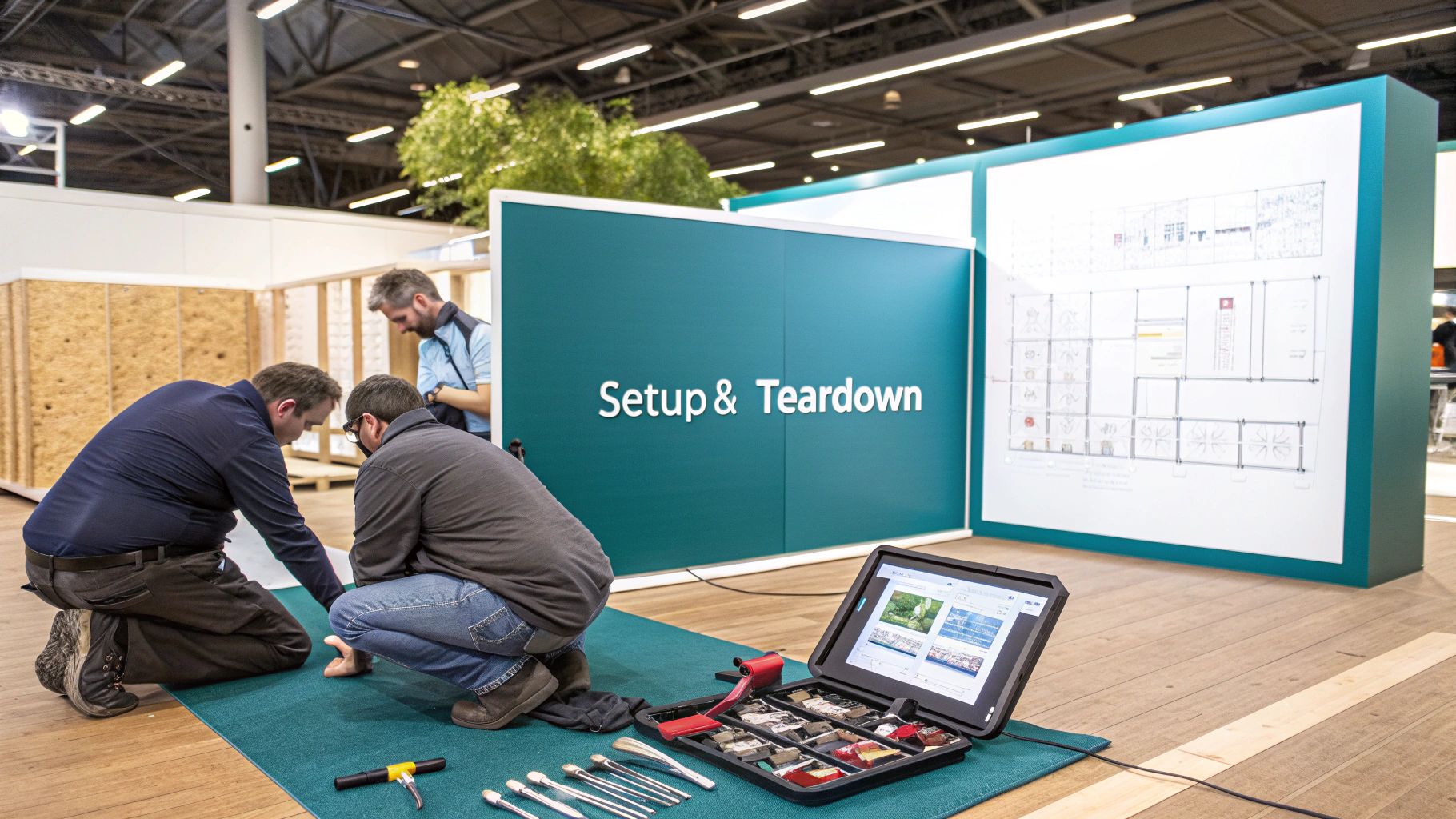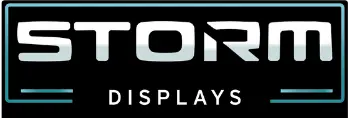You’ve invested months of effort and a significant portion of your marketing budget into designing the perfect trade show booth. But what happens if it arrives damaged, late, or not at all? Even the most innovative display and compelling sales pitch can be completely undermined by a single logistical misstep. A delayed shipment, surprise on-site fees, or damaged components can quickly turn a golden opportunity into a costly headache.
For marketing managers and exhibit coordinators, navigating the complex world of trade show logistics is a high-stakes challenge. This guide is your strategic blueprint for ensuring your exhibit investment pays off, delivering your booth on time, in pristine condition, and ready for your team to shine.
Why a Smart Trade Show Logistics Strategy is Non-Negotiable
Think of your logistics plan as the central nervous system of your entire trade show presence. It connects every critical element, from the initial booth design to the final handshake with a promising new lead. Without a solid plan, you're not just hoping for the best—you're gambling with your ROI.
A well-executed logistics strategy frees up your team to focus on what they do best: engaging attendees and generating business. Poor planning, on the other hand, creates a domino effect of stress and unexpected costs. We’ve seen it happen: custom booth components arrive cracked from improper packing, or a team gets hit with exorbitant "forced freight" charges because their driver missed a tight delivery window. These are the preventable nightmares that foresight and expertise can eliminate.
The Foundation of a Successful Exhibit
Before you ship anything, you must know what you're shipping. A critical first step is cataloging all the essential trade show products you’ll need. Every single item, from a large backlit display down to the last box of brochures, must have a place in your plan.
A proactive approach to logistics is the single most effective way to control costs and reduce stress. Instead of reacting to problems on the show floor, you anticipate them months in advance.
This guide will break down each stage of the process, providing a battle-tested playbook for a seamless event. We'll cover:
- Strategic Budgeting and Timelines: Learn how to account for every potential cost, especially "hidden" fees like drayage and on-site electrical services.
- Choosing the Right Partners: Discover how to vet and select a freight carrier that truly understands the unique, time-sensitive demands of trade shows.
- On-Site Coordination: Master the installation and dismantle (I&D) process for a smooth setup and a swift, painless teardown.
Getting these elements right ensures your booth is ready and your team is positioned for success the moment the show doors open.
Building Your Logistics Budget and Timeline
Great trade show logistics don't begin at the loading dock; they start months in advance with a meticulous budget and a detailed timeline that works backward from show day. Neglecting these foundational steps is a surefire way to encounter surprise fees and last-minute chaos that can derail your entire event.
The scale of this industry highlights the importance of precise planning. The global event logistics market was valued at around USD 75.16 billion in 2025 and is projected to hit USD 99.74 billion by 2030, according to this event logistics industry report. This growth underscores how seriously companies are investing in getting their logistics right.
This timeline provides a bird's-eye view of how all the pieces should fit together, from initial design to final shipment.

As you can see, each step builds on the one before it. Follow the sequence, and you ensure a smooth process. Get it wrong, and you'll face costly backtracking and stressful delays.
Uncovering the Hidden Costs in Your Budget
One of the most common mistakes in trade show planning is assuming the logistics budget begins and ends with the shipping quote. That freight bill is merely the tip of the iceberg. To create an accurate financial plan, you must account for all the ancillary costs that often go overlooked.
A comprehensive budget includes:
- Drayage (Material Handling): This is the non-negotiable fee charged by the show's official contractor to move your materials from the loading dock to your booth space. It’s expensive, unavoidable, and typically billed by weight.
- Installation & Dismantle (I&D) Labor: Whether you hire the show's crew or bring in your own team, the cost of setting up and tearing down your booth is a significant expense.
- Advance Warehousing: Sending your crates to the show’s warehouse ahead of time is a smart strategy, but it comes with fees for storage and handling before your materials reach the convention center.
- Special Handling Fees: Oversized crates or unconventionally packed items will incur extra charges. Any special equipment needed to move your booth will also add to the bill.
Don’t just budget for what you think it will cost; budget for what it could cost. Build a contingency fund of at least 10-15% to absorb unexpected fees, overtime labor charges, or last-minute shipping adjustments.
Crafting a Master Timeline That Prevents Panic
Your timeline is your strategic roadmap. The most effective way to build it is to start at the end and work your way back. Pinpoint the day your booth must be 100% show-ready, and then map out every milestone backward from that date.
This approach forces proactive decision-making. For example, knowing your booth must ship by October 15th creates urgency for the design team to finalize graphics by their deadline. When early milestones slip, it creates a domino effect of rush charges and expensive, expedited shipping. If you're already behind, understanding how to plan custom trade show booths on a tight timeline is critical.
Here’s what backward planning looks like in practice:
- Show Opens: Your booth is standing, lit, and ready for visitors.
- Exhibitor Move-In: Mark the first day you can access the exhibit hall.
- Freight Arrives: Your crates must be at the venue's dock.
- Shipment Date: Your carrier picks everything up from your warehouse.
- Production Complete: Your booth is built, packed, and awaiting pickup.
This simple shift transforms trade show logistics from a frantic, reactive scramble into a controlled, predictable process. When your budget and timeline are locked in, you’re not just hoping for success—you’re planning for it.
Choosing the Right Shipping and Freight Partners
Your choice of a shipping partner can single-handedly determine the success of your trade show. This isn’t just about moving crates from Point A to Point B; you are entrusting a critical component of your marketing investment to a team that must understand the unforgiving, time-crunched world of live events. One missed delivery window or a pallet of damaged graphics can derail months of careful planning.
Think of your logistics partner as an extension of your own team. Their performance directly impacts your ability to execute your strategy on the show floor, making this one of the most crucial decisions in your entire plan.

Common Carriers vs. Specialized Exhibit Houses
A common mistake for first-time exhibitors is treating trade show freight like a standard shipment and hiring a general LTL (less-than-truckload) carrier. While excellent for regular freight, they are often ill-equipped for the unique pressures of an event. Their business model prioritizes volume and route efficiency, not hitting a precise 30-minute check-in window at a chaotic convention center.
Specialized exhibit transportation companies, on the other hand, live and breathe this environment. They understand the nuances of marshalling yards, the politics of the show floor, and the specific paperwork required for each venue.
Here’s how they compare:
- Common Carriers (LTL): They may appear cheaper upfront, but they typically offer vague delivery windows like "sometime between 8 AM and 5 PM," which is unworkable for a show with a strict move-in schedule.
- Specialized Carriers: You receive guaranteed delivery times, on-site support, and drivers who know how to navigate the check-in process. Their established relationships with show contractors can be a lifesaver.
Choosing a carrier without trade show-specific experience is a significant risk. You might save a few hundred dollars on the initial quote, but you could end up paying thousands in forced freight fees, crew overtime, and lost sales opportunities when they inevitably miss their slot.
Key Questions to Vet Potential Partners
Before signing any contract, you need to conduct thorough due diligence. A reliable partner will welcome your questions and provide clear, confident answers. Their responses will reveal their level of experience and their ability to perform under pressure.
Ask pointed questions about their process for time-sensitive deliveries. Who monitors your shipment at 2 AM? What is the contingency plan if a truck breaks down? A premier partner will have proactive communication and emergency plans built into their service. On-site support is another non-negotiable. Confirm if they have representatives at major shows or, at a minimum, a dedicated 24/7 contact who can solve problems in real-time. This person is your lifeline when challenges arise on the show floor.
A Vetting Checklist for Your Logistics Partner
Choosing the right carrier is all about asking the right questions. The table below outlines the essential criteria for evaluating potential shipping partners. Use it to guide your conversations and ensure no detail is left to chance.
Carrier Selection Checklist for Trade Show Logistics
| Evaluation Criteria | Key Questions to Ask | Why It Matters |
|---|---|---|
| Venue Experience | "Have you delivered to this specific convention center before? Can you provide examples?" | Familiarity with a venue's docks, rules, and personnel is priceless. It prevents common mistakes and delays. |
| Tracking Technology | "What kind of tracking and visibility will I have? Do you offer real-time GPS and proactive alerts?" | You need to know exactly where your exhibit is at all times. Passive tracking is no longer sufficient. |
| Insurance & Liability | "What are your liability limits? How do you handle claims?" | Understand their coverage and federal regulations like the Carmack Amendment, which dictates carrier liability for cargo loss or damage. |
| Handling Capabilities | "Can you handle both advance warehouse and direct-to-show-site shipments?" | A flexible partner can adapt to your strategy for each event, giving you more options for timing and cost savings. |
| Proper Equipment | "Are your trucks equipped with lift gates and air-ride suspension? What about straps and blankets?" | Your custom exhibit and sensitive electronics need protection. The right equipment prevents costly damage during transit. |
Making an informed decision based on these points will save you immense stress. It’s the difference between a smooth setup and a frantic, costly scramble.
Mastering On-Site Logistics: I&D and Drayage
You’ve successfully navigated budgeting, timelines, and shipping. Now, the final phase of your logistics plan unfolds on the show floor. Managing the on-site installation and dismantle (I&D) and understanding the nuances of drayage are where your meticulous planning pays off.
This is where your vision becomes a physical space. The goal is simple: get your booth built correctly, on time, and without incurring excessive overtime charges. A cool head combined with a rock-solid plan is your greatest asset.

Demystifying Drayage (Material Handling)
Of all the costs that surprise exhibitors, drayage is the most notorious. Also called material handling, it's the non-negotiable fee the show's official contractor charges to move your freight from the loading dock to your booth space and back again. For many, it becomes one of the largest line items on the final invoice.
Think of the convention center as its own ecosystem. Once your carrier unloads your freight, the show contractor takes control of every on-site movement. You pay for this service by weight, typically calculated per 100 pounds (a CWT, or hundredweight). This single fee covers unloading, transport to your booth, storing empty crates, returning them post-show, and moving your packed freight back to the dock.
Because drayage is mandatory and monopolized, your only defense is a good offense. Small decisions made months in advance can have a massive impact on your final bill.
Actionable Strategies to Reduce Drayage Costs
You can’t eliminate drayage, but you can manage it. The key is to reduce your shipment's weight and make it as easy as possible for the on-site crew to handle.
- Consolidate Everything: Pack all items onto a single, neatly organized pallet. Multiple loose boxes can trigger minimum charges and special handling fees. Shrink-wrap the entire pallet to create one solid unit.
- Lighten Your Load: Since drayage is a game of pounds, swapping heavy materials for lighter alternatives can slash your costs. Modern, lightweight fabric structures and modular trade show displays offer a stunning look without the punishing weight, directly cutting down on shipping and drayage expenses.
- Label Everything: Every crate and box needs a clear label on all visible sides with your company name, booth number, and the show name. This prevents items from getting lost and ensures your entire shipment arrives together.
Executing a Flawless Installation and Dismantle (I&D)
Your I&D process is the final execution of your plan. Whether you use the show's official general contractor or hire an independent Exhibitor Appointed Contractor (EAC), clear communication is essential.
Your I&D team is only as good as the instructions you provide. A detailed setup plan—complete with crystal-clear schematics, electrical layouts, and photos of the finished booth—is non-negotiable. It eliminates guesswork and empowers the crew to work quickly and accurately.
During setup, your role is to direct traffic, solve problems, and keep everything moving. Huddle with the labor lead, connect with other vendors like electricians before flooring is laid, and ensure empty crates are properly labeled and stored.
A great show ends with a teardown that is just as organized. The moment the show closes, your first move is to locate your empty crates. As the I&D crew packs, your focus should shift to the outbound paperwork. Fill out the Material Handling Agreement (MHA)—your outbound Bill of Lading (BOL)—with meticulous accuracy. Double-check the carrier name, destination address, and piece count. A sloppy MHA is the #1 reason freight gets lost or rerouted after a show.
By mastering on-site processes, you turn potential chaos into a controlled, efficient operation, protecting your investment and ensuring a professional presence from start to finish.
At Storm Displays, we've seen it all, and we know that a successful trade show starts long before you hit the floor. It starts with smart logistics. We work with companies across the country to manage every piece of the puzzle, from designing lightweight exhibits that save on shipping to making sure everything arrives on time.
Ready to stop worrying about logistics and start focusing on your leads? Explore our custom and modular trade show display solutions or request a quote from our team today.

